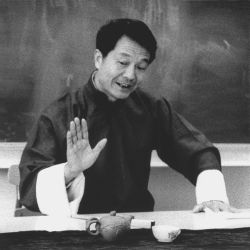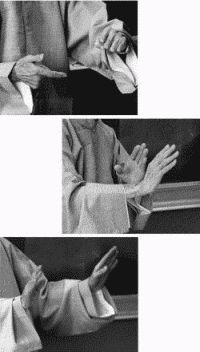Elements of Performance (7)

Gestures and face expressions
"kou, shou, shen, bu, shen
Mouth, hand, body, step, look "
The importance of both language and body language is expressed in the above saying, numbering the five basic elements of storytelling: "mouth" points to the art of telling; "hand" symbolizes gesture; "body" stands for body movements; "step" stands for movements of the legs in sitting or standing; "look" means the expression of the face and eyes. The acting gestures and face expressions of the Yangzhou storytellers show a considerable influence from Chinese drama. During the students' rehearsals with his master, the gestures and "looks" are rigorously studied together with the words that go with each movement.

The Yangzhou storytellers traditionally sit down at the table and act using only moderate movements of hands and feet, called "small frame" xiao jiazi, occasionally standing for a short while, but not moving far away from the table, called "the half open door" xiao kai men . This is in contrast to some of the other storytelling traditions that may allow more moving around or may demand less freedom of movement and even smaller gestures. Nowadays some performers of Yangzhou storytelling tend to go in the direction of more freedom: using the "big frame" da jiazi and switching to Suzhou style "wide open door" da kai men.
Videos:
Gestures (Wang Xiaotang)
wmv 1.1Mb
mpeg 3.7Mb
Face Expressions (Dai Buzhang)
wmv 2.5Mb
mpeg 8.1Mb
Next: Verbal art